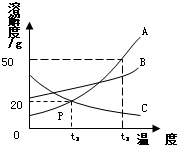根据右图A、B、C三种固体的溶解度曲线回答:

(1)P点的含义是 。
(2)要使C的饱和溶液成为不饱和溶液,可采用的一种
方法是 。
(3)要从含有少量A的B溶液中得到较多的B晶体,通常采用的方法是 。
(4)t1℃时,将15gA加入到装有50g水的烧杯中,充分搅拌,所得溶液的溶质质量分数为 (结果精确至0.1%)。
(5)将t2℃时三种物质的饱和溶液分别降温到t1℃,所得溶液中溶质的质量分数最小的是 (填序号)。
(1)t1℃时,A,C的溶解度相等(答案合理即可)
(2)降温(答案合理即可)(3)蒸发结晶(4)16.7%(5)C
题目分析:(1)P点的含义是)t1℃时,A,C的溶解度相等;
(2)要使C的饱和溶液成为不饱和溶液,可采用的一种方法是降温(或者加入溶剂);
(3)要从含有少量A的B溶液中得到较多的B晶体,通常采用的方法是蒸发结晶,因为B得溶解度受温度影响不大;
(4)t1℃时,A的溶解度是20g,50克水最多溶解10gA,故将15gA加入到装有50g水的烧杯中,充分搅拌,所得溶液的溶质质量分数为 =16.7%;
=16.7%;
(5)将t2℃时三种物质的饱和溶液分别降温到t1℃,所得溶液中溶质的质量分数最小的是C。因为t2℃时三种物质中,C的溶解度最小,溶液中含有的溶质最少,降温后,虽然它的溶解度增大了,但溶液中溶质的质量没有增大,其质量分数还是最小的。
点评:溶解度曲线图中,曲线的交叉点,表示该温度下,各物质的溶解度相等;
溶质质量分数= 。
。
